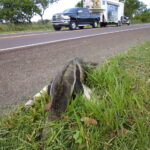In recent months, dozens of beekeepers have met with biologists and researchers to develop a guide to coexistence with giant armadillos in areas where beekeepers have installed hives.
The giant armadillo (Priodontes maximus) is the largest of all extant armadillo species in the world, reaching up to one and a half meters in length (from snout to tail) and weighing more than 50 kilos. This rare and endangered animal largely feeds on termites, ants, and occasionally some fruit. However, the continuous and growing rate of deforestation in the Cerrado, one of the giant armadillo’s main habitats, is reducing its food supply and creating an unexpected challenge to coexistence with beekeepers. It was precisely to improve this coexistence between armadillos and beekeepers that the Wild Animal Conservation Institute (ICAS) and the Institute for Ecological Research (IPÊ) created the Armadillos and Honey project in 2016.
Biologist Arnaud Desbiez, researcher and coordinator of the Giant Armadillo Conservation Program, which has been operating in the Pantanal since 2010, explains that while carrying out a complementary research study with the objective of mapping out the occurrence of giant armadillos in the Cerrado of Mato Grosso do Sul (MS), Brazil, specialists explored about 500 watersheds with fragments of native vegetation in search of the presence of this animal. They interviewed about 1000 people, among them beekeepers, who reported that in addition to the occurrence of the species, there was also an issue with giant armadillo attacks on their beehives.
“It took three years of study before we understood that this behavior reflected deforestation, because, in places where native vegetation remains intact, this animal has access to plenty of resources to feed itself. However, in places surrounded by roads, pasture, and cropland, food has become scarce, and so armadillos began to attack beehives to survive. Today, we know that the armadillo’s habitat is extremely fragmented. That is why, they are often isolated in one of these fragments, without many food options, and they end up being forced to look for alternatives to feed themselves, such as, bee larvae in hives,” Desbiez explains.
The giant armadillo reaches sexual maturity between 7 and 9 years of age and has only one pup per gestation, every three years, meaning the species has a slow rate of reproduction, making population recovery difficult
The giant armadillo is nocturnal and has some of the longest and sharpest nails in nature (its third fingernail measures about 14 centimeters), which it uses to dig urrows that can reach up to 4 meters deep. These burrows end up serving as shelters for 70 other species after the giant armadillo leaves for elsewhere. Camera traps set up by ICAS researchers recorded how giant armadillos learned to knock over beehive boxes at night. The images show them standing up on their hind legs, hanging, and pulling and pushing boxes until they get access to the larvae, knocking down the honey and releasing the bees.
It was precisely because of this survival behavior that this animal got a bad reputation among beekeepers in the region. Many of them were interested in solving the problem in a way that would not be lethal to the animal, as many understand that nature conservation is very important for beekeeping. However, some reported not seeing any other alternative to minimize the damage caused by this species’ new habit.

Beekeeper Adriano Adames, who has been producing and selling honey for 30 years in Campo Grande, capital of Mato Grosso do Sul, explains that a single beehive can cost an average of R$ 700, not including maintenance costs, and that he has already suffered financially from a giant armadillo attack on his apiary, which at the time had 70 beehives, resulting in significant economic losses.
“The owner of the farm where I kept my apiary suggested a drastic solution and asked me why I didn’t just kill the armadillo. But even though I was upset about the beehives, I knew it wasn't the right thing to do, and I would never do that. I’ve heard that some beekeepers have killed armadillos, but I’m against it, because it’s not the animal’s fault,” he said. Adriano was the first of currently 33 beekeepers in the state of MS to receive the seal for “Giant armadillo-friendly product”, which ensures the beekeepers’ commitment to biodiversity and the protection of these animals.
This certification, recognized by the international organization for nature conservation Wildlife Friendly Enterprise Network, is part of the project’s strategy to encourage sustainable production and consumption that protects the biome and wildlife. As part of this strategy, we also launched the “Guia de Convivência entre apicultores e tatus-canastra no Cerrado do Mato Grosso do Sul”(Guide to Coexistence between beekeepers and giant armadillos in the Cerrado of Mato Grosso do Sul) (click HERE to access this material, available in Portuguese), bringing together techniques that the beekeepers themselves proposed and tested to prevent giant armadillo attacks on beehives.
The project’s biologist and technician, Marcos José Wolf, explains that if the beehives are less than 1.3 meters from the ground, armadillos can reach them by standing on their hind legs. As such, one of the main recommendations in the manual is to increase the distance between the hives and the ground and add stands to the structure made of metal or wood that can better withstand the strength of the giant armadillo. These and other valuable tips contained in the manual hinder and can even completely eliminate these animal attacks on the hives, preventing damage and promoting harmonious coexistence with this species.
“In some cases, the guide recommends the installation of a wire or electric fence around the beehive that gives out a small electrical pulse to scare the armadillo away, but not hurt it. It all depends on the type and conditions of each property. That is why, before receiving certification – which can generate financial benefits when selling honey, we visit, follow up, and suggest techniques and give recommendations that can lead to greater success in that location, as well as sign a contract between the project and the beekeeper,” Marcos highlighted.
The aim of this certification initiative is for honey with the seal to improve beekeepers’ income from market sales, along with internet sales. To that end, producers must become aware of the importance and advantages of conserving nature since beehives also need a healthy environment. Therefore, if you produce honey and its derivatives in an area where giant armadillos occur and want to be part of this conservation initiative and receive the “Giant armadillo-friendly product” seal, please contact us via email: contato@icasconservation.org.br.
The Armadillos and Honey project receives financial support from Fundação Grupo Boticário (Boticário Group Foundation), Whitley Fund for Nature, Houston Zoo, Wilhelma Zoo, the Zoological Society for the Conservation of Species and Populations, and the Disney Conservation Fund.





